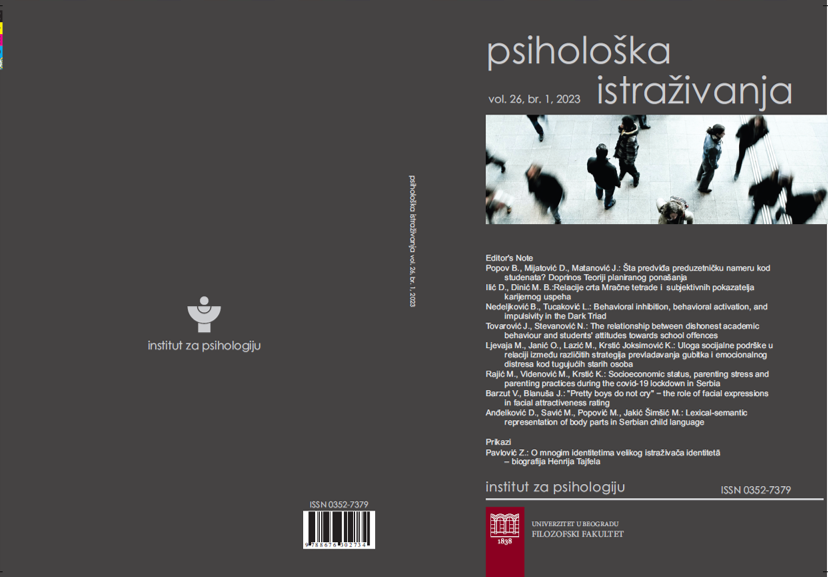Pretty boys do not cry: The role of facial expressions on facial attractiveness rating
Sažetak
Facial attractiveness is the concept that is widely explored in the previous studies. Many research tried to identify key factors that are affecting aesthetic judgment of faces. Some of these factors are symmetry, averageness, and facial expressions. Our study aimed to explore whether the presence of different facial expressions affects aesthetic judgment. A total of 61 students took part in this study. They evaluated female and male faces with expressions of happiness, anger, sadness, or neutral on several scales (Beautiful, Pleasant, Attractive, and Harmonious). Results showed that overall female faces were rated as more attractive, beautiful, and pleasant, but not harmonious. Furthermore, faces with expressions of anger and sadness were rated lower on each scale compared to neutral and happy faces. However, sad male faces were rated lower compared to sad female faces. One of the possible explanations for such a result could be the role of the social context where society discourages the display of certain emotions, particularly for men.
Reference
Ekman, P. (1992). Facial expressions of emotion: New findings, new questions. Psychological Science, 3, 34 –38. https://doi.org/10.1111/j.1467-9280.1992.tb00253.x
Garrido, M. V., & Prada, M. (2017). KDEF-PT: valence, emotional intensity, familiarity and attractiveness ratings of angry, neutral, and happy faces. Frontiers in Psychology, 8, 2181. https://doi.org/10.3389/fpsyg.2017.02181
Hamermesh, D. S., & Parker, A. (2005). Beauty in the classroom: Instructors’ pulchritude and putative pedagogical productivity. Economics of Education Review, 24, 369-376.
Izard, C. E. (1971). The face of emotion. East Norwalk, CT: Appleton-Century-Crofts.
Langlois, J. H., & Roggman, L. A. (1990). Attractive faces are only average. Psychological Science, 1, 115-121. https://doi.org/10.1111/j.1467-9280.1990.tb00079.x
Langlois, J. H., Kalakanis, L., Rubenstein, A. J., Larson, A., Hallam, M., & Smoot, M. (2000). Maxims or myths of beauty? A metaanalytic and theoretical review. Psychological Bulletin, 126, 390-423. https://doi.org/10.1037/0033-2909.126.3.390
Marlowe, C. M., Schneider, S. L., & Nelson, C. E. (1996). Gender and attractiveness biases in hiring decisions: Are more experienced managers less biased? Journal of Applied Psychology, 81, 11-21
Mueser, K. T., Grau, B. W., Sussman, S., & Rosen, A. J. (1984). You’re only as pretty as you feel: Facial expression as a determinant of physical attractiveness. Journal of Personality and Social Psychology, 46, 469-478. https://doi.org/10.1037/0022-3514.46.2.469
Perrett, D. I., Burt, D. M., Penton-Voak, I. S., Lee, K. J., Rowland, D. A., & Edwards, R. (1999). Symmetry and human facial attractiveness. Evolution and Human Behavior, 20, 295-307.
Perrett, D. I., Lee, K. J., Penton-Voak, I., Rowland, D., Yoshikawa, S., Burt, D. M., . . . Akamatsu, S. (1998). Effects of sexual dimorphism on facial attractiveness. Nature, 394, 884-887.
Reis, H. T., Wilson, I. M., Monestere, C., Bernstein, S., Clark, K., Seidl, E., . . . Radoane, K. (1990). What is smiling is beautiful and good. European Journal of Social Psychology, 20, 259-267. https://doi.org/10.1002/ejsp.2420200307
Rhodes, G., Hickford, C., & Jeffery, L. (2000). Sex-typically and attractiveness: Are supermale and superfemale faces superattractive? British Journal of Psychology, 91, 125-140. https://doi.org/10.1348/000712600161718
Rhodes, G., Proffitt, F., Grady, J. M., & Sumich, A. (1998). Facial symmetry and the perception of beauty. Psychonomic Bulletin & Review, 5, 659-669.
Scheib, J. E., Gangestad, S. W., & Thornhill, R. (1999). Facial attractiveness, symmetry and cues of good genes. Proceedings of Royal Society, Series. B: Biological Sciences, 266, 1913-1917. https://doi.org/10.1098/rspb.1999.0866
Thornhill, R., & Gangestad, S. W. (1993). Human facial beauty: Averageness, symmetry, and parasite resistance. Human Nature, 4, 237-269.
Tracy, J. L., & Beall, A. T. (2011). Happy guys finish last: The impact of emotion expressions on sexual attraction. Emotion, 11(6), 1379–1387. https://doi.org/10.1037/a0022902
Tracy, J. L., & Matsumoto, D. (2008). The spontaneous display of pride and shame: Evidence for biologically innate nonverbal displays. Pro-ceedings of the National Academy of Sciences, USA, 105, 11655–11660.
Ueda, R., Kuraguchi, K., & Ashida, H. (2016). Asymmetric effect of expression intensity on evaluations of facial attractiveness. SAGE Open, 6(4), 2158244016677569. https://doi.org/10.1177/2158244016677569
Van Hemert, D. A., van de Vijver, F. J., & Vingerhoets, A. J. (2011). Culture and crying: Prevalences and gender differences. Cross-Cultural Research, 45(4), 399-431. DOI: 10.1177/1069397111404519
Watkins, L. M., & Johnston, L. (2000). Screening job applicants: The impact of physical attractiveness and application quality. International Journal of Selection and Assessment, 8, 76-84. https://doi.org/10.1111/1468-2389.00135
Autori zadržavaju autorska prava nad objavljenim člancima, a izdavaču daju neekskluzivno pravo da članak objavi, da u slučaju daljeg korišćenja članka bude naveden kao njegov prvi izdavač, kao i da distribuira članak u svim oblicima i medijima. Objavljeni članci distribuiraju se u skladu sa licencom Creative Commons Autorstvo – Deliti pod istim uslovima 4.0 International (CC BY-SA) . Dopušteno je da se delo kopira i distribuira u svim medijima i formatima, da se prerađuje, menja i nadograđuje u bilo koje svrhe, uključujući i komercijalne, pod uslovom da se na pravilan način citiraju njegovi prvobitni autori, postavi link ka originalnoj licenci, naznači da li je delo izmenjeno i da se novo delo objavi pod istom licencom kao i
originalno. Autorima je dozvoljeno da objavljenu verziju rada deponuju u institucionalni ili tematski repozitorijum ili da je objave na ličnim veb stranicama (uključujući i profile na društvenim mrežama, kao što su ResearchGate, Academia.edu, itd.), na sajtu institucije u kojoj su zaposleni, u bilo koje vreme nakon objavljivanja u časopisu, uz adekvatno referisanje.

